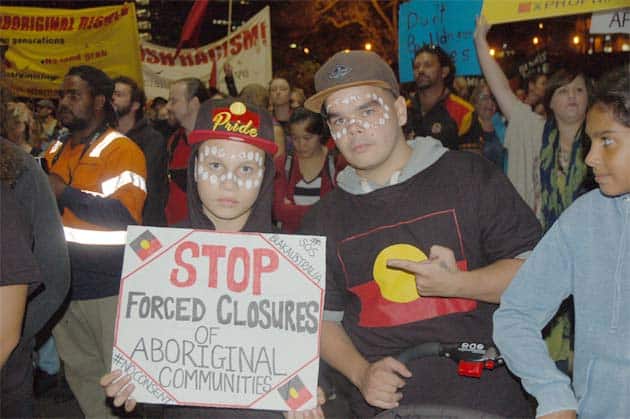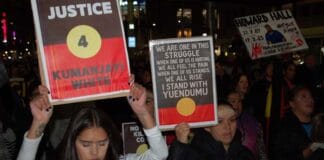Paddy Gibson looks at the renewed push to close remote Aboriginal communities and how it began with the NT Intervention from 2007.
On 12 May, Four Corners aired a disgraceful hatchet job on remote Aboriginal communities in WA. It was a very useful piece of propaganda for the Western Australian government, which is currently moving to close communities down.
The program was full of government officials making lurid allegations, unchallenged by the reporter, of rampant child sexual abuse, precisely the same racist smear campaign that was launched just prior to the Northern Territory Intervention in 2007.
WA Police Commissioner Karl O’Callaghan said, “knowing what I know, it’s very difficult to sleep at night knowing that we cannot protect those children in any effective way.”
Premier Colin Barnett was shown speaking in parliament about 38 reported cases of the STI gonorrea in minors, disingenuously ignoring the fact, pointed out by remote health workers, that most such cases result from the consensual sexual activity of young teens.
But the actual facts, or the interests of the children, mean nothing to these officials.
Forcing young children and their families from remote areas into homelessness on the fringes of regional centres such as Wyndham or Broome is a funny kind of “protection”.
In the case of the NT Intervention in 2007, ABC current affairs program Lateline provided a similar platform for Minister Mal Brough to declare that “pedophile rings” were active in every community in the NT.
For the opening phase of the Intervention, this allegation worked to isolate the communities, scaring off many progressive organisations from coming out in clear condemnation of the policy.
But in 2009, the Australian Crime Commission confirmed after extensive investigation that not a single pedophile ring had been found in any NT community.
From the NT Intervention to community closures
The Howard government fought hard to build a political consensus around the alleged “failure” of self-determination in Aboriginal affairs, and the need to return to policies of assimilation—including forcing migration from remote communities. This assimilation drive serves an important function for the ruling class in Australia.
Firstly, it pathologises Aboriginal people and culture, shifting the blame for the very real social problems that do exist in many communities, a result of ongoing colonial oppression and criminal neglect by government, onto its victims. Aboriginal people are constantly framed as a “problem to be managed”, rather than a proud people with rights to the provision of basic services like other Australian citizens, and particular rights to self-determination, land and compensation for the genocidal process unleashed by British invasion.
Secondly, the brand of assimilation encouraged by Howard has a hard neo-liberal economic edge. The communities are framed as “economically unviable”, and embracing the market is promoted as a panacea for social ills. Finally, the continued existence of Aboriginal people serves as a constant reminder that the capitalist system imposed on Australia is based on theft and genocide. Breaking up forms of collective Aboriginal life is an attempt to bury this reality, and stop the constant challenges to the legitimacy of the system that come from Aboriginal people.
Announcing the NT Intervention in 2007, Howard declared “Aboriginal people have no place outside of the Australian mainstream”. Previous Aboriginal Affairs Minister Amanda Vanstone had already floated the prospect of closing remote communities, disgracefully branding them “museum pieces”.
The NT Intervention poured hundreds of millions of dollars into the NT to build new bureaucracies of control. But the money available to Aboriginal people trying to live on their lands evaporated, almost overnight. The national Community Development Employment Program (CDEP)—which employed 7500 people across NT Aboriginal communities in a multitude of services from essential municipal works to schools, was shut down. Most of these people were simply put on the dole and subjected to “income management”.
The NT Government was simultaneously implementing reforms which saw around 50 local Aboriginal Community Government Councils disbanded in favour of a handful of “mega-Shires”. Many of the productive assets that communities relied on that were attached to the CDEP or the local council were simply confiscated, including earth-moving equipment, road graders, community buses and vehicles—essential equipment required for community life in remote areas.
While the Intervention was the main pretext for introducing this policy, it hit hard Australia wide. Almost 40,000 Aboriginal people had been employed on CDEP before its closure. Rene Adams, head of the Toomelah Aboriginal Co-op in North West NSW told Tracker magazine in 2012, “all people who were on CDEP are basically unemployed now… Mental health issues and suicides have increased. There’s more drugs, more violence, more alcohol. It’s heart breaking.”
The Intervention is an apartheid-style regime where Aboriginal lives are brought directly under the control of government, as they were for much of the 20th Century.
Under the “Stronger Futures” policy, brought in by Labor in 2012 to continue the Intervention, Aboriginal people remain subject to draconian controls through “income management” and extreme, racialised police powers.
Prison numbers have exploded. Special “child protection” squads focussed on Aboriginal communities are removing children at historic rates. Since 2007 there has been more than a five-fold increase in reported incidents of attempted suicide and self-harm, while rates of hospitalisation for domestic violence keep increasing.
Starving communities
In December 2007, under the new Labor government, the Council of Australian Governments (COAG) signed a “National Partnership Agreement on Remote Indigenous Services”, which sounded the death-knell for Commonwealth support for remote communities.
It established the category of “priority communities”, that is, “larger and more economically sustainable communities where secure land tenure exists”. This amounted to just 35 communities, out of many hundreds across the country. It compels governments to “avoid expectations of major investment in service provision” outside these communities and encourages “facilitating voluntary mobility by individuals and families to areas where better education and job opportunities exist”.
Aboriginal people everywhere have been sent a clear message: there is no hope for a better life in their community—they must leave their land in order to find work and housing.
The Commonwealth planned to withdraw entirely from providing funding for the provision of essential services such as water and power in remote Aboriginal communities. Labor Minister Jenny Macklin continued to make the annual, meagre payments to state and NT governments to keep the lights and taps on—but precious little else.
Now the Abbott government, as part of their 2014 and 2015 budgets, have made lump sum payments, including $90 million for WA and $150 million for the NT, that would keep services going for a few years and pledged that all the funding will stop after this. While only Barnett in WA has openly said this will mean communities close, all Aboriginal communities are vulnerable without ongoing Commonwealth funding.
Just providing water and power however, is no way to keep a community functioning. A petition from the Yalata community in South Australia of more than 300 people estimates that the Community Council now has only 10 per cent of the funding needed to operate:
“The Community Council provides municipal services, manages the power station and water supply, women’s services, community landscaping, youth work and training, mail collection, an internet centre, community administration, night patrol, building crew, land management and run the community store. The only funding allocated under the Indigenous Advancement Strategy (current budget) was a small amount for an after school kids club and night patrol.”
Thousands of people across Australia have taken to the streets to demonstrate against the WA community closures, in the largest and most militant wave of Aboriginal rights protests for some time.
As veteran Aboriginal activist Gary Foley told more than 10,000 protestors in Melbourne however, “there are a multitude of issues”. Foley cited the ever growing mass incarceration of Aboriginal people. Protests across the country have heard speakers rail against the half a billion dollar cut from vital Aboriginal programs in the last budget. The attacks on Aboriginal people are just as real in the city as the bush, with attempts to take over the historic Block in Redfern for corporate development, and community controlled organisations being defunded and mass child removal alongside the farce of “constitutional recognition”.
In response to the protests, Barnett has softened his rhetoric. Whereas he was previously threatening the imminent closure of 150 communities, he now claims there is “no hit list”, and that “extensive consultation” will be undertaken before any communities are closed. Minister Collier called desperately for “an end to the national protests”, giving guarantees that any closures would be by “choice”. Both men maintain however, that there are currently “too many” communities.
The truth is that remote communities have been under attack for many years even before this announcement, with places like Oombulgurri and Coonana in WA closed in the last two years and thousands more Aboriginal people leaving their lands right across Australia as services and job opportunities are withdrawn.
The 2015 budget did nothing to restore funding, and in fact intensified the push for people to leave their lands. Funding ear-marked for remote Indigenous housing has been reallocated to build houses in towns for people relocating for work. Millions of dollars will go on subsidies to big corporations to employ Indigenous people (mostly in non-permanent positions), while the only “employment” in the bush is the draconian 25 hour work-for-the-dole.
Elite boarding schools are receiving millions more to take remote Aboriginal kids, while the NT government is moving to close down remote high-schools and some primary schools.
It took mass mobilisation and the militant black politics of the late 1960s and 1970s to turn back assimilation and put self-determination and liberation on the agenda. The campaign against the NT Intervention played an important role in winning the battle of public opinion and discrediting the Intervention. But it never built up the social power required to actual defeat the policy. The current protests against community closures are the best chance in many years to begin to turn this situation around.






